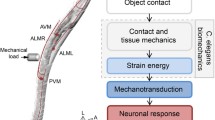Abstract
The paper presents a neural network model of the touch sensitivity circuit of the nematode Caenorhabditis elegans. We describe a serie of simulations in which neural networks are trained, using a genetic algorithm, to reproduce the habituation of the nematode's touch sensitive behavior. A lesion study of the network allows to make a direct comparison between the fine functioning of the model and the data collected in real organisms. The model accords well with the known neurobiological data and it suggests some hypotheses about the functioning of the neural circuit and of single neurons.
Similar content being viewed by others
References
T.J. Sejnowski, C. Koch and P.S. Churchland, “P.S. Computational neuroscience”, Science, Vol. 241, pp. 1299–1306, 1988.
S.R. Lochery and T.J. Sejnowsky, “Distributed processing of sensory information in the Leech. III. A dynamical neural network model of the local bending reflex”, Journal of Neuroscience, Vol. 12, pp. 3877–3895, 1992.
M. Chalfie, J.E. Sulston, J.C. White, E. Southgate, J.N. Thomson and S. Brenner, “The neural circuit for touch sensitivity in Caenorhabditis elegans”, Journal of Neuroscience, Vol. 5, pp. 959–964, 1985.
S.R. Wicks and C.H. Rankin, “Integration of mechanosensory stimuli in Caenorhabditis elegans”, Journal of Neuroscience, Vol. 15, pp. 2434–2444, 1995.
W.B. Wood (ed), The Nematode Caenorhabditis elegans, Cold Spring Harbor Laboratory, 1988.
J.P. Walrond and A.O. Stretton, “Reciprocal Inhibition in the motor nervous system of the nematode Ascaris: direct control of ventral inhibitory motoneurons by dorsal excitatory motoneurons”, Journal of Neuroscience, Vol. 5, pp. 9–15, 1985.
J.J Holland, Adaptation in Natural and Artificial Systems, Ann Arbor, Michigan: University of Michigan Press, 1975.
C.H. Rankin, C.D. Beck and C.M. Chiba, “Caenorhabditis elegans: a new model system for the study of learning and memory”, Behavioral Brain Research, Vol. 37, pp. 89–92, 1990.
J.G. White, D.G. Albertson and M.A. Anness, “Connectivity changes in a class of motoneurone during the development of a Nematode”, Nature, Vol. 271, pp. 764–766, 1978.
P.M. Groves and R.F. Thompson, “Habituation: a dual process theory”, Psychological Review, Vol. 77, pp. 419–450, 1970.
Author information
Authors and Affiliations
Rights and permissions
About this article
Cite this article
Cangelosi, A., Parisi, D. A Neural Network Model of Caenorhabditis Elegans: The Circuit of Touch Sensitivity. Neural Processing Letters 6, 91–98 (1997). https://doi.org/10.1023/A:1009615807222
Issue Date:
DOI: https://doi.org/10.1023/A:1009615807222




